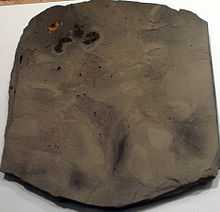Ypresiomyrma
| Ypresiomyrma Temporal range: Ypresian, 55.4–51Ma | |
|---|---|
 | |
| Ypresiomyrma rebekkae fossils | |
| Scientific classification | |
| Kingdom: | Animalia |
| Phylum: | Arthropoda |
| Class: | Insecta |
| Order: | Hymenoptera |
| Family: | Formicidae |
| Tribe: | †incertae sedis |
| Genus: | †Ypresiomyrma Archibald, Cover, & Moreau, 2006 |
Ypresiomyrma is an extinct genus of bulldog ants in the subfamily Myrmeciinae which contains three described species.[1] One species is known from the Isle of Fur in Denmark and two are from the McAbee Fossil Beds in British Columbia, Canada.[1]
History and classification
Fossils of Ypresiomyrma were first studied and described by Bruce Archibald, Stefan Cover and Corrie Moreau of the Museum of Comparative Zoology in Cambridge, Massachusetts. They published their 2006 description of the genus and species in an Annals of the Entomological Society of America journal article.[1] The genus name is a combination of Ypresian, referring to the age of the specimens and the Greek myrmex, meaning "ant".[1]
Along with the genus description, the paper contained descriptions of the type species Ypresiomyrma orbiculata and Ypresiomyrma bartletti, both from the McAbee Fossil Beds in British Columbia. Archibald, Cover and Moreau also included a redescription of the Danish species Pachycondyla rebekkae under the new name combination Ypresiomyrma rebekkae.[1]
Description
There are several characteristics that separate Ypresiomyrma from other ant genera. The waist connecting the thorax and the abdomen in Ypresiomyrma is composed of a single segment. The mandibles are a distinct triangular shape and shorter in length then the head capsule. Queens of the genus are large, being over 20 millimetres (0.79 in) in length.[1]
Y. orbiculata
Y. orbiculata was described from a single part and counterpart compression fossil found at the Middle Ypresian McAbee Fossil Beds, Kamloops Group, near Cache Creek, British Columbia. The specimen, numbered UCCIPR L-18 F-749 and UCCIPR L-18 F-750 for the part and counterpart respectively, is currently preserved in the paleoentomology collections housed at Thompson Rivers University, in Kamloops, British Columbia.[1] Archibald, Cover, and Moreau coined the specific epithet from the Latin "orbiculatus", meaning "rounded" or "circular", in reference to the shape of the head. The species is discernible from the other two species of Ypresiomyrma by its notably rounded head capsule, and by the shape of the petiole which is a smoothly sloping convex shape with a node in the center. The queen is estimated to have been approximately 25 millimetres (0.98 in) in length.[1]
Y. bartletti
The second species described from the McAbee Fossil Beds is Y. bartletti which, like Y. orbiculata, is known from a single specimen. The holotype part and counterpart are included in the Geological Survey of Canada, Ottawa collections as GSC 127632a and GSC 127632b.[1] The shape of head is subtriangular, which separates it from Y. orbiculata, and at an estimated 20 millimetres (0.79 in) it is smaller than Y. rebekkae. The petiole shape in Y. bartletti is distinct from both other species. The specific epithet was chosen in honor of Rod Bartlett who collected the specimen, and to honor his work with the Vancouver Paleontological Society and the British Columbia Paleontological Alliance.[1]
Y. rebekkae

This species is known from over 100 specimens collected from the earliest Ypresian Ølst and Fur Formations. The specimens were first studied and described by Jes Rust and N. Møller Andersen in 1999, and they named the species for Rebekka Madsen who collected the type specimen in September 1994.[2] The part and counterpart, GMUC No. 1995 8B and GMUC No. 1995 8A are deposited in the Geological Museum of the University of Copenhagen. At that time Rust and Andersen placed the species into the modern ponerin genus Pachycondyla based on the shape of the abdominal segment VI and lack of dentition on the mandibles. Archibald, Cover, and Moreau moved the species to Ypresiomyrma based on the similarity to the McAbee species, by the shape of the abdominal segment III, which differs from that found in the Ponerinae subfamily genera, and by the morphology of the petiole.[1] The species is known almost exclusively from queens, with only one known male ant assigned to it by Rust and Andersen.[1][2]
References
- ↑ 1.0 1.1 1.2 1.3 1.4 1.5 1.6 1.7 1.8 1.9 1.10 1.11 Archibald, S.B.; Cover, S. P.; Moreau, C. S. (2006). "Bulldog Ants of the Eocene Okanagan Highlands and History of the Subfamily (Hymenoptera: Formicidae: Myrmeciinae)" (PDF). Annals of the Entomological Society of America 99 (3): 487–523. doi:10.1603/0013-8746(2006)99[487:BAOTEO]2.0.CO;2.
- ↑ 2.0 2.1 Rust, J.; Andersen, N. M. (1999). "Giant ants from the Paleogene of Denmark with a discussion of the fossil history and early evolution of ants (Hymenoptera: Formicidae)" (PDF). Zoological Journal of the Linnean Society 125: 331–348. doi:10.1111/j.1096-3642.1999.tb00596.x.